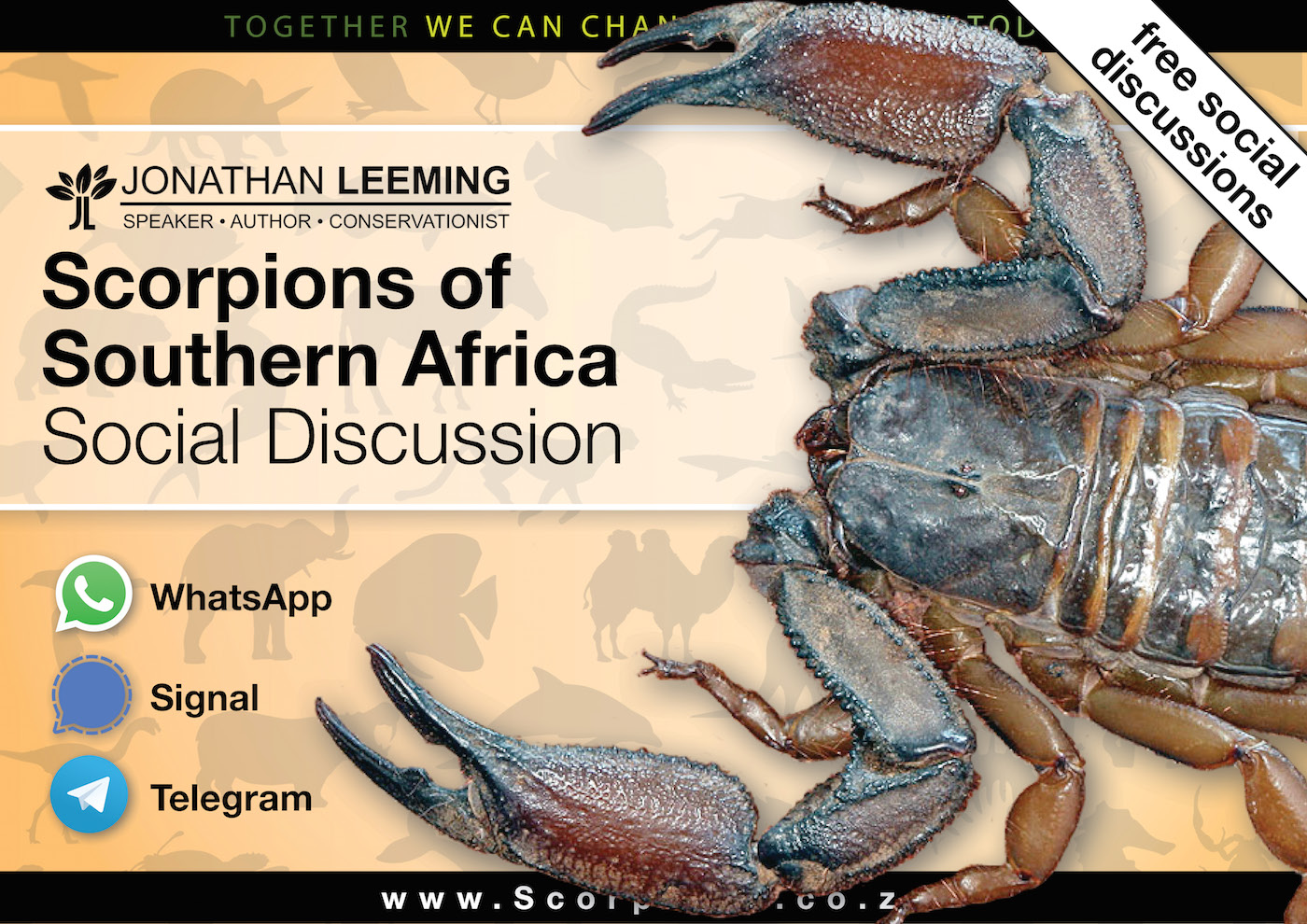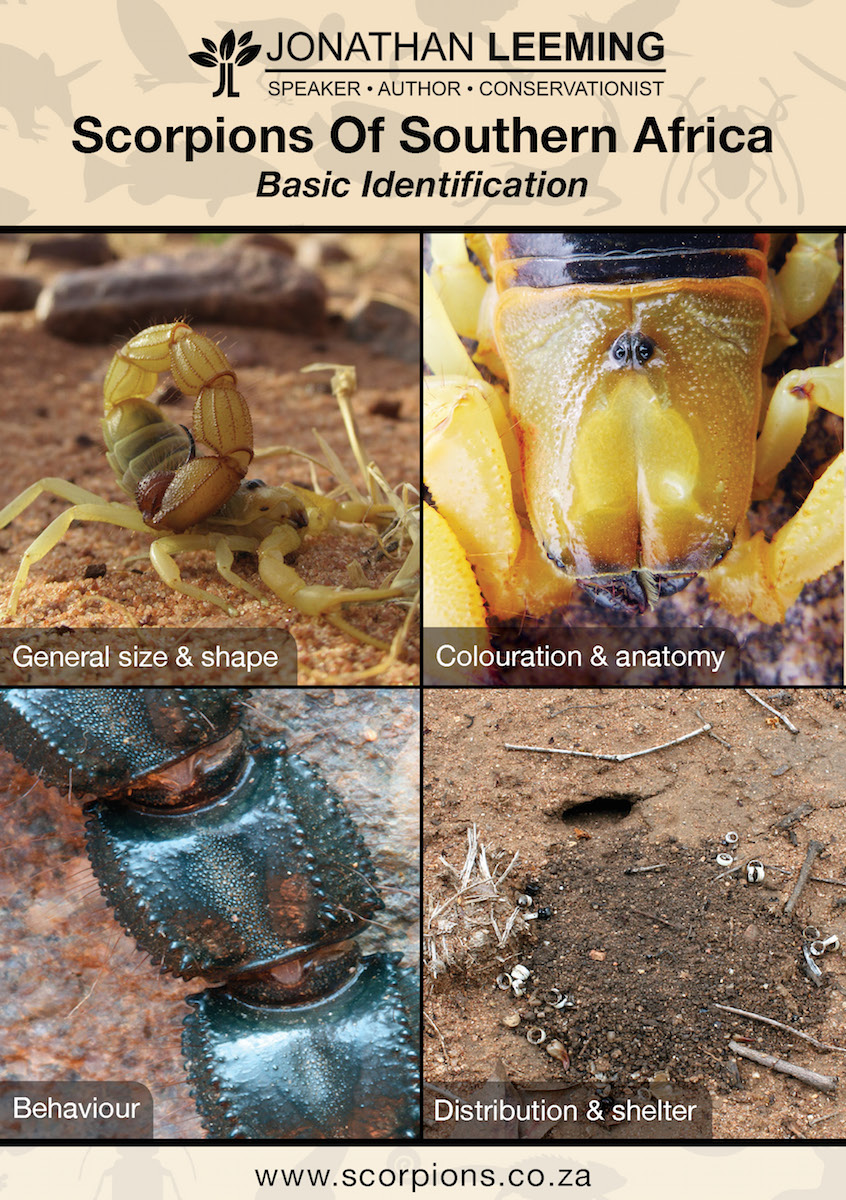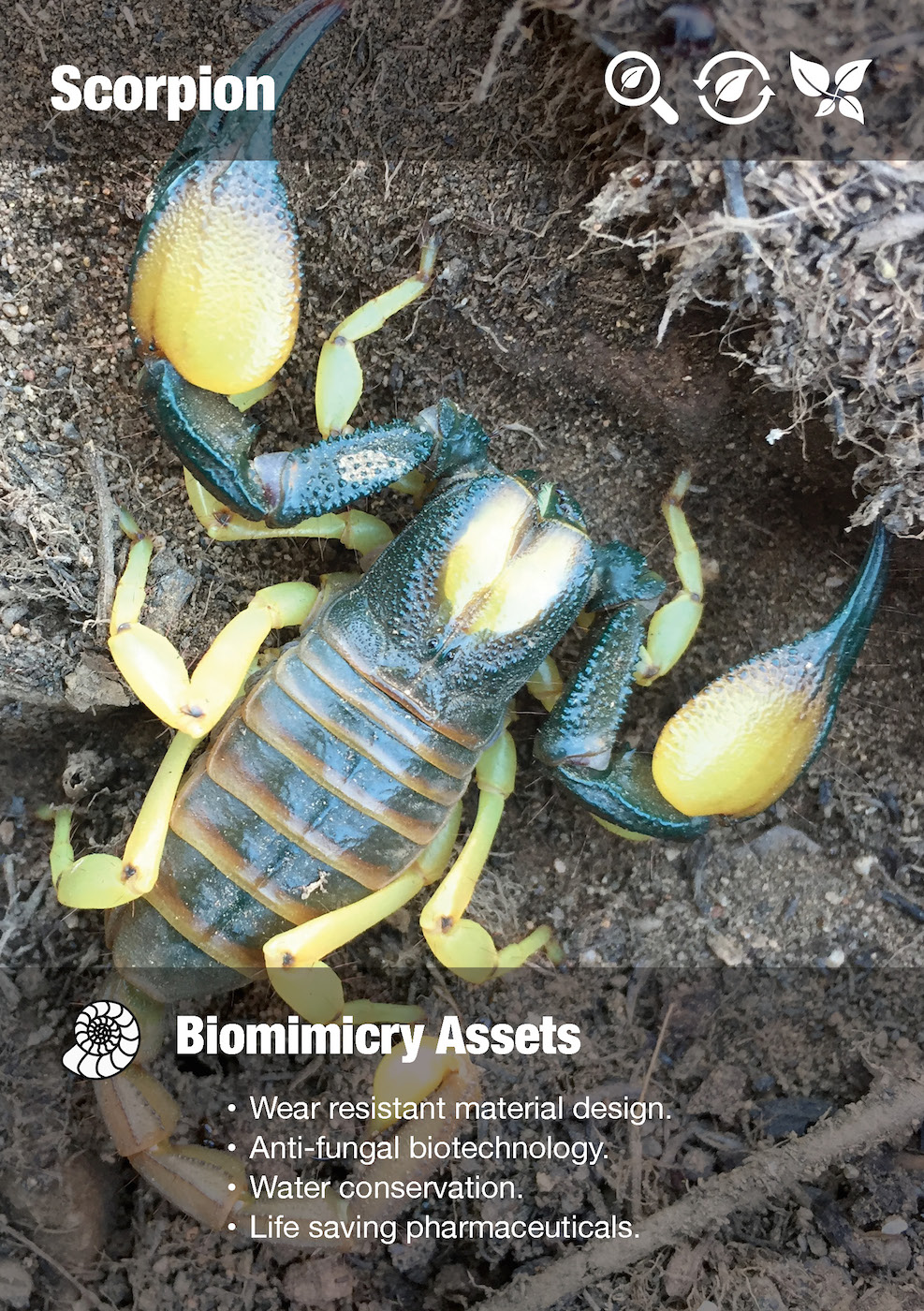Thank you for participating in this week long glimpse into the world of Scorpions of Southern Africa. The following is a summary of the weeks discussions.
Each section contains links that will help you explore the day's topic and your relationship with the world. If you have any comments or would like to just say thanks, please go to the bottom of the page a leave a comment.

Southern Africa is home to about 150 species of scorpions, occurring in just about every terrestrial habitat except for high mountain peaks. Scorpion identification is a bit of a dark art, thanks to factors such as a dated and very technical identification keys. However, we can use the following to help identify a scorpion.
With practise and patience, it is possible to identify most species of scorpion with ease, however there are a few species that even the 'experts' find very difficult to identify.
If you enjoyed this section then you will love my Spiders of Southern Africa Natural History Presentation and my Arachnid Course.

Our values and beliefs are a lens through which we experience the world. It’s interesting to note that those people who are afraid of venomous animals are the same people who know the least about them. These individuals become susceptible to misinformation, dodgy newspaper articles, social media rubbish and neighbourhood gossip. This creates a cycle of perpetual fear, which generates more ignorance which in turn, creates more fear. This cycle of fear and ignorance can be broken through deepening our knowledge and understanding.
French writer Anais Nin said “ we don’t see things as they are, we see things as we are”. If the first question you ask when you see a scorpion is how dangerous is it, then I would suggest you re-evaluate your values and beliefs. Venomous animals are not dangerous, it is our interaction with that animal which introduces the element of danger.
I would encourage you to spend 10 minutes and explore your values and beliefs towards the environment through a simple yet thought provoking online workshop tool. There are 27 online cards that get the conversation going! 27 Inspiring quotes from One World, 27 ways to deepen your connection to the environment, 27 ways to create the future.
If you enjoyed this section then you will love my Creepy Crawly Walk, my Bite Me! Presentation and my Free Bite Me! Online Workshop Tool.

During the iron age, the action of venom represented a magical and evil force that was unfathomable and mysterious. These iron aged beliefs still exist today. For many people a scorpion represents a negative aspect of the natural world that has no value. This cannot be further from reality.
Venomous animals represent our furtherest point of our disconnection from the natural world. When people ask me what is the value of a scorpion, what they really mean, what is the value of a scorpion within the constraints of their values and beliefs. We have to realise that every aspect of the environment adds value in its own unique way. If you do not know what the value of a scorpion is, it does not mean that it doesn't have value! It just means that you do not know what that value is.
There are many things that we do not understand in the world. To think that we know everything about everything is testament to the egotistical mindset of mankind that is the root cause of so many of the challenges that we face as a society.
Scorpions are highly important middle tier predators in an ecosystem. They prey upon a variety of animals and in turn, are preyed upon. There are many biomimicry assets that have been derived from scorpions. From water conservation strategies, selective insecticide, treatments for Alzheimer’s disease and brain cancer, organ rejection prevention, and malaria control. Venoms have become a focus of research due to the ability to solve some of the greatest health threats of our time.
If you enjoyed this section then you will love my Creepy Crawly Walk my Biomimicry Walk and my Deadly Innovation Presentation.
According to the WWF’s living planet report of 2020, human activities and influence, populations of mammals, birds, fish, amphibians and reptiles have decreased on average by 68% since 1970. Scorpions have not escaped the death and destruction that mankind exerts upon the environment.
There are 3 layers of legislation that protect scorpions from exploitation.
Why the need for legislative protection? Poaching for the pet trade and habitat destruction exerts a huge negative influence upon animal and plant populations. At Kloofendal Nature reserve we have seen a dramatic increase in illegal poaching of not only scorpions but also spiders and other small animals and plants. These illegal activities are happening all over Gauteng.
Conservation efforts to protect scorpions include habitat conservation, having your say in development applications, not killing scorpions intentionally, avoiding the use of insecticides, keep domestic cats indoors at all times, do not buy wild animals or support the pet trade, if you see anyone collecting scorpions (or other animals and plants), immediately report them to the local authorities. These conservation efforts not only assist scorpions but also other animals and plants.
If you enjoyed this section then you will love my Conservation Leadership Presentation.

All scorpions have neurotoxic venom that can have a profound affect upon our nervous system. In southern Africa we have the worlds least venomous, plus the 12th most venomous scorpion in the world! In between these extremes, scorpion stings exhibit a wide range of symptoms.
Size and colouration has nothing to do with a scorpion’s venomosity. The venomosity rule of thumb is an easy method for estimating the venomosity of a scorpion just by its appearance. This method applies within a southern African context, however there are a few exceptions to this rule in other parts of the world.

In southern Africa, 2 species of scorpion are responsible for a small number of deaths annually, usually young infants and the aged. First response should be focused upon understanding the severity of the situation, and if necessary, transporting the patient to professional medical assistance.
Antivenom is the most effective medical treatment for life threatening symptoms. The South African Vaccine Producers, manufacture monovalent scorpion antivenom that is effective in halting the symptoms of all species of highly venomous scorpion in southern Africa.
If you enjoyed this section then you will love my Essential First Response Seminar and my Spider bite And Scorpion Sting First Aid Course.
There are many conservation efforts in your area that not only conserve scorpions, but all aspects of our local environment. Conservation takes doing, if you want to assist in conserving where you live, then please consider getting involved with one of the many projects, or begin at home or your garden.
If you enjoyed this series of posts, then you will LOVE my Scorpion Sting First Response Seminar. This 45 minute seminar provides a structured framework that will greatly reduce the risk of being stung by a scorpion, and provide the best possible outcome, should a scorpion sting occur in both humans and pets. I have adapted it for presenting online and have online resources to help the audience implement what they learn.
You will also enjoy my latest book entitled One World. I wrote it for anyone who considers themselves living through a period of change, is uncertain about the future, and who wants to make the world a better place. One World is available for purchase from Wildbooks.
Lastly, if you can use some educational material then go to www.Scorpions.co.za and www.Jonathanleeming.com for free online educational resources (posters, workshop tools, social media memes) and articles.

I'm on a mission to reduce the burden of spider bites and scorpion stings across Southern Africa!
Newsletter | Public Events | Books & Workbooks | Presentations | Activities |Professional Development | Shop


Fantastic, informative info, have learned a lot.
Hi Annamarie, thanks you for the comment. I've had some great feedback from the posts!
Good day Jonathan. "Snakes, spiders and scorpions", your best friends are my worst enemies!!! But with all due respect they were put on our earth for a job they have to do in nature.
After following your information on scorpions, I have actually become interested in scorpions and I would like to learn more about them. After learning more from you about spiders and snakes, I might have more respect for them too.